Scientists have found that some antibodies, created by the immune system during infection with common cold coronaviruses, can also target the COVID-19 causing SARS-CoV-2, and may confer a degree of protection against the new virus.
The researchers, including those from the Francis Crick Institute in the UK, explained that in response to viral infection, the immune system creates antibodies to help fight it, which remain in the blood for a period, and prevent re-infection.
In the new study, published in the journal Science, the scientists found that some people, notably children, have antibodies reactive to the novel coronavirus SARS-CoV-2 in their blood, despite not ever having being infected with the virus.
They said these antibodies are likely the result of exposure to other coronaviruses, which cause a common cold and have structural similarities with SARS-CoV-2.
Using highly sensitive antibody tests for COVID-19 which the researchers developed, they compared the blood of patients with the novel coronavirus infection to patients who had not had the disease.
The scientists found that some people who had not been exposed to SARS-CoV-2 had antibodies in their blood which would recognise the virus.
To confirm their findings, they analysed over 300 blood samples collected before the pandemic, between 2011 and 2018.
Nearly all samples had antibodies that reacted with common cold coronaviruses, which was expected given how everyone has been exposed to these viruses at some point in their lives, the study noted.
However, a small fraction of adult donors, about one in 20, also had antibodies that cross-reacted with SARS-CoV-2, and this was not dependent on recent infection with a common cold coronavirus, it said.
According to the researchers, such cross-reactive antibodies were found much more frequently in blood samples taken from children aged six to 16.
“Our results show that children are much more likely to have these cross-reactive antibodies than adults,” said Kevin Ng, lead author of the study from the Francis Crick Institute in the UK.
“More research is needed to understand why this is, but it could be down to children being more regularly exposed to other coronaviruses,” he added.
The scientists believe these higher levels observed in children may also explain why they are less likely to become severely ill with COVID-19.
In the lab, the scientists tested the antibodies they found in blood from uninfected people to confirm that these can neutralise SARS-CoV-2.
They found the cross-reactive antibodies target the S2 subunit of the spike protein on the surface of the virus, which it uses to enter host cells.
“The S1 subunit allows the virus to latch onto cells and is relatively diverse among coronaviruses, whereas the S2 subunit lets the virus into cells and is more similar among these viruses,” explained George Kassiotis, senior author of the study from the Francis Crick Institute.
“Our work shows that the S2 subunit is sufficiently similar between common cold coronaviruses and SARS-CoV-2 for some antibodies to work against both,” Kassiotis said.
While earlier studies hinted that only antibodies to S1 could block infection, the researchers said from there is “good evidence now” that some antibodies to S2 “can be just as effective.”
“This is exciting as understanding the basis for this activity could lead to vaccines that work against a range of coronaviruses, including the common cold strains, as well as SARS-CoV-2 and any future pandemic strains,” Kassiotis said.
However, the scientists said several questions from the study remain unanswered which require further research.
“For example, exactly how is immunity to one coronavirus modified by exposure to another? Or why does this activity decline with age? It is not the case that people who have recently had a cold should think they are immune to COVID-19,” Kassiotis added.






